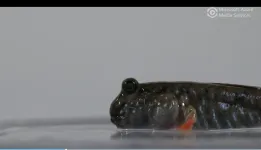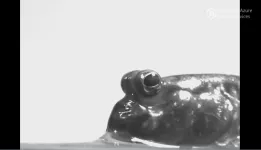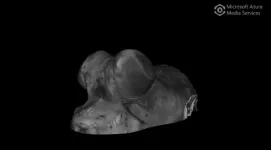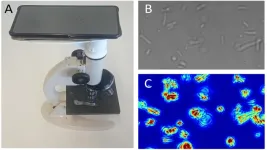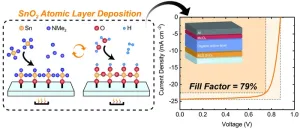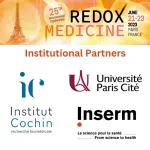(Press-News.org) UNIVERSITY PARK, Pa. — An unusual blinking fish, the mudskipper, spends much of the day out of the water and is providing clues as to how and why blinking might have evolved during the transition to life on land in our own ancestors. New research shows that these amphibious fish have evolved a blinking behavior that serves many of the same purposes of our blinking. The results suggest that blinking may be among the suite of traits that evolved to allow the transition to life on land in tetrapods — the group of animals that includes mammals, birds, reptiles and amphibians — some 375 million years ago.
The study appears the week of April 24 in the Proceedings of the National Academy of Sciences and was led by Thomas Stewart, assistant professor of biology at Penn State, and Brett Aiello, assistant professor of biology at Seton Hill University.
“Animals blink for many reasons,” said Stewart. “It helps us keep our eyes wet and clean, it helps us protect our eyes from injury, and we even use blinking for communication. Studying how this behavior first evolved has been challenging because the anatomical changes that allow blinking are mostly in soft tissues, which don’t preserve well in the fossil record. The mudskipper, which evolved its blinking behavior independently, gives us the opportunity to test how and why blinking might have evolved in a living fish that regularly leaves the water to spend time on land.”
To understand how mudskippers evolved the ability to blink, the researchers analyzed the behavior with high-speed videos and compared the anatomy of mudskippers with that of a closely related water-bound fish that doesn't blink. The mudskipper’s eyes bulge out of the top of their heads, like a frog’s eyes. To blink, the fish momentarily retract the eyes down into sockets, where they are covered by a stretchy membrane called a “dermal cup.” The mudskipper’s blink lasts about the same length of time as a human blink.
“Blinking in mudskippers appears to have evolved through a rearrangement of existing muscles that changed their line of action and also by the evolution of a novel tissue, the dermal cup,” said Aiello. “This is a very interesting result because it shows that a very rudimentary, or basic, system can be used to conduct a complex behavior. You don’t need to evolve a lot of new stuff to evolve this new behavior — mudskippers just started using what they already had in a different way.”
To uncover why mudskippers blink on land, the team considered the roles that blinking plays in humans and other tetrapods. In humans, tears are critical to keep cells in the eye healthy and oxygenated, so the researchers analyzed whether mudskippers also blink to keep their eyes wet.
“We found that, just like humans, mudskippers blink more frequently when confronted with dry eyes,” said Aiello. “What’s incredible is that they can use their blinks to wet the eyes, even though these fish haven’t evolved any tear glands or ducts. Whereas our tears are made by glands around our eyes and on our eyelids, mudskippers seem to be mixing mucus from the skin with water from their environment to produce a tear film.”
The research team also tested whether blinking in mudskippers could be triggered to protect the eye from possible injury and if blinking cleaned the fish’s eyes of dust or debris. In both cases the answer was “yes.” Therefore, blinking in the mudskippers seems to fulfill three of the main functions of blinking — protecting, cleaning, and maintaining moisture — in humans and other tetrapods.
“Our study, which considered the behavior and anatomy of a living fish that underwent a transition to life on land, similar to the earliest tetrapods, helps us to reimagine how and why these early tetrapods might have been blinking,” said Aiello. “Having the opportunity to study how and why this behavior first evolved provides an amazing opportunity to learn more about the way humans came to be as they are and gives us insight into changes associated with major transitions in the history of animals — like inhabiting land.”
Blinking is something that humans and other tetrapods are constantly doing throughout the day, often without even noticing it happens, Aiello explained. Despite being a subtle action, blinking is actually quite complex and fascinating, because it is a single behavior that can perform multiple functions, which are all critical to the health and safety of the vertebrate eye, he said.
“The transition to life on land required many anatomical changes, including changes for feeding, locomotion and breathing air,” said Stewart. “Based on the fact that mudskipper blinking, which evolved completely independently from our own fishy ancestors, serves many of the same functions as blinking in our own lineage, we think that it was likely part of the suite of traits that evolved when tetrapods were adapting to live on land.”
In addition to Stewart and Aiello, the research team includes M. Saad Bhamla, Jeff Gau, Kenji Bomar, Shashwati da Cunha, Harrison Fu, Julia Laws, Hajime Minoguchi, Manognya Sripathi, Kendra Washington, Gabriella Wong and Simon Sponberg at the Georgia Institute of Technology; John G.L. Morris at Westmead Hospital in Sydney, Australia; and Neil H. Shubin at the University of Chicago.
The research was funded by the U.S. National Science Foundation, the Open Philosophy Project, the U.S. National Institutes of Health, the Biological Sciences Division of The University of Chicago, and the Brinson Foundation.
END
A blinking fish reveals clues as to how our ancestors evolved from water to land
New research links the evolution of blinking to the transition to life on land
2023-04-24
ELSE PRESS RELEASES FROM THIS DATE:
New machine-learning method predicts body clock timing to improve sleep and health decisions
2023-04-24
A new machine-learning method could help us gauge the time of our internal body clock, helping us all make better health decisions, including when and how long to sleep.
The research, which has been conducted by the University of Surrey and the University of Groningen, used a machine learning programme to analyse metabolites in blood to predict the time of our internal circadian timing system.
To date the standard method to determine the timing of the circadian system is to measure the timing of our ...
Health surveys, studies exclude trans people and gender-diverse communities, impacting health care
2023-04-24
ANN ARBOR—Health surveys and clinical studies have a data collection problem: Because of the way they record sex or gender, they often exclude transgender and gender-diverse people, according to University of Michigan research.
Most studies and surveys either ask participants for their sex, a biological construct, or their gender, a social construct. In this way, they only consider either sex or gender independently or use the two concepts interchangeably, says Kate Duchowny, a research assistant professor in the Survey Research Center at the U-M Institute for Social Research.
Participants either respond with their sex assigned at birth or the ...
Scientists detect seismic waves traveling through Martian core for the first time
2023-04-24
Scientists observed seismic waves traveling through Mars’ core for the first time and confirmed model predictions of the core’s composition.
An international research team—which included University of Maryland seismologists—used seismic data acquired by the NASA InSight lander to directly measure properties of Mars’s core, finding a completely liquid iron-alloy core with high percentages of sulfur and oxygen. Published in the Proceedings of the National Academy of Sciences on April 24, 2023, these findings reveal new insights into how Mars formed and geological differences ...
Pioneering research sheds new light on the origins and composition of planet Mars
2023-04-24
A new study has uncovered intriguing insights into the liquid core at the centre of Mars, furthering understanding of the planet’s formation and evolution.
The research, led by the University of Bristol and published in the journal Proceedings of the National Academy of Sciences of the US, reveals the first-ever detections of sound waves travelling into the Martian core. Measurements from this acoustic energy, called seismic waves, indicate its liquid core is slightly denser and smaller than previously thought, and comprises a mixture of iron and numerous other elements.
The ...
Testing antibiotic resistance with a fast, cheap, and easy method
2023-04-24
“We have developed a technique in our laboratories that allows us to obtain an antibiogram within 2-4 hours – instead of the current 24 hours for the most common germs and one month for tuberculosis,” says Dr Sandor Kasas at EPFL. Professor Ronnie Willaert at Vrije Universiteit Brussel adds: “Our technique is not only faster but also simpler and much cheaper than all those existing now.”
Antibiotic resistance happens when bacteria develop the ability to defeat the drugs designed to kill them. It ...
Interfering with antiviral pathway may deter Alzheimer’s disease and frontotemporal dementia
2023-04-24
Targeting part of an antiviral pathway triggered by the accumulation of a key pathogen shared in Alzheimer’s disease and frontotemporal dementia may one day offer a new therapeutic approach to deterring or delaying cognitive decline, according to preclinical research led by Weill Cornell Medicine scientists.
The study, published April 24 in Nature Neuroscience, demonstrates that inhibiting an innate immune system enzyme called cyclic GMP–AMP synthase (cGAS) helps neurons become resilient to the build-up of the protein tau into bundles known as fibrils, a hallmark of Alzheimer’s and some forms of frontotemporal dementia, the two most ...
Outstanding performance of organic solar cell using tin oxide
2023-04-24
Organic solar cells have a photoactive layer that is made from polymers and small molecules. The cells are very thin, can be flexible, and are easy to make. However, the efficiency of these cells is still much below that of conventional silicon-based ones. Applied physicists from the University of Groningen have now fabricated an organic solar cell with an efficiency of over 17 percent, which is in the top range for this type of material. It has the advantage of using an unusual device structure that is produced using a scalable technique. The design involves a conductive layer of tin oxide that is grown ...
Redox Medicine 2023: Where is the target?
2023-04-24
The 25th International Conference on Redox Medicine will take place on June 21-23 in Paris. Redox Medicine 2023 will provide a glimpse into the role of redox in tomorrow’s medicine.
What to Expect in Redox Medicine 2023?
Reactive oxygen species (ROS) have been studied for decades, but the results remain controversial. ROS are beneficial to biological mechanisms, acting as signaling molecules and enhancing immune defense. However, they also have harmful effects, such as causing tissue and organ damage.
Dr. Carole Nicco, stated that “The work and results presented at the Redox Medicine Congress will give ...
Small acts of kindness are frequent and universal, study finds
2023-04-24
Key takeaways
A study by researchers from UCLA, Australia, Ecuador, Germany, the Netherlands and the U.K. found that people around the world signal others for assistance every couple of minutes.
The research, which examined behaviors in towns and rural areas in several different countries, revealed that people comply with these small requests for help far more often than they decline them.
The findings suggest that people from all cultures have more similar cooperative behaviors than prior research has established.
A new study by UCLA sociologist Giovanni Rossi and an international team of collaborators finds that people rely on ...
Department of Energy to support 999 outstanding undergraduate students and 79 faculty members from institutions underrepresented in the scientific research enterprise
2023-04-24
WASHINGTON, DC – The Department of Energy’s (DOE’s) Office of Science will sponsor the participation of 999 undergraduate students and 79 faculty members in three STEM-focused workforce development programs at 16 DOE national laboratories and a national fusion facility during summer 2023. Collectively, these programs ensure DOE and our nation have a strong, sustained workforce trained in the skills needed to address the energy, environment, and national security challenges of today and tomorrow.
“Our future depends on the next generation ...
LAST 30 PRESS RELEASES:
NSF–DOE Vera C. Rubin Observatory spots record-breaking asteroid in pre-survey observations
Ribosomal engineering creates “super-probiotic” bacteria
This self-powered eye tracker harnesses energy from blinking and is as comfortable as everyday glasses
Adverse prenatal exposures linked to higher rates of mental health issues, brain changes in adolescents
Restoring mitochondria shows promise for treating chronic nerve pain
Nature study identifies a molecular switch that controls transitions between single-celled and multicellular forms
USU chemists' CRISPR discovery could lead to single diagnostic test for COVID, flu, RSV
Early hominins from Morocco reveal an African lineage near the root of Homo sapiens
Small chimps, big risks: What chimps show us about our own behavior
We finally know how the most common types of planets are created
Thirty-year risk of cardiovascular disease among healthy women according to clinical thresholds of lipoprotein(a)
Yoga for opioid withdrawal and autonomic regulation
Gene therapy ‘switch’ may offer non-addictive pain relief
Study shows your genes determine how fast your DNA mutates with age
Common brain parasite can infect your immune cells. Here's why that's probably OK
International experts connect infections and aging through cellular senescence
An AI–DFT integrated framework accelerates materials discovery and design
Twist to reshape, shift to transform: Bilayer structure enables multifunctional imaging
CUNY Graduate Center and its academic partners awarded more than $1M by Google.org to advance statewide AI education through the Empire AI consortium
Mount Sinai Health system receives $8.5 million NIH grant renewal to advance research on long-term outcomes in children with congenital heart disease
Researchers develop treatment for advanced prostate cancer that could eliminate severe side effects
Keck Medicine of USC names Christian Pass chief financial officer
Inflatable fabric robotic arm picks apples
MD Anderson and SOPHiA GENETICS announce strategic collaboration to accelerate AI-driven precision oncology
Oil residues can travel over 5,000 miles on ocean debris, study finds
Korea University researchers discover that cholesterol-lowering drug can overcome chemotherapy resistance in triple-negative breast cancer
Ushikuvirus: A newly discovered giant virus may offer clues to the origin of life
Boosting the cell’s own cleanup
Movement matters: Light activity led to better survival in diabetes, heart, kidney disease
Method developed to identify best treatment combinations for glioblastoma based on unique cellular targets
[Press-News.org] A blinking fish reveals clues as to how our ancestors evolved from water to landNew research links the evolution of blinking to the transition to life on land
